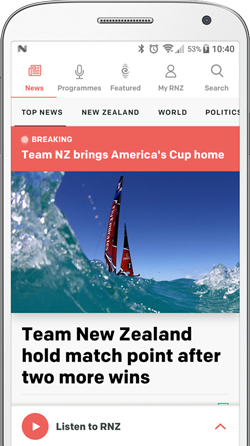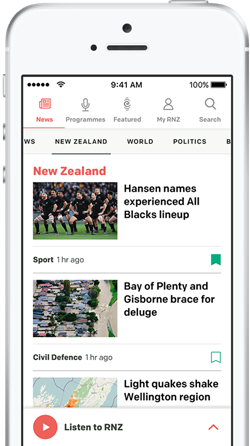
Wellington Airport was evacuated for a security scare in late 2023. Photo: RNZ / Rhonwyn Newson
New Zealanders are very used to skipping security for regional plane flights - even for some between major cities.
Screening is not mandatory for flights carrying fewer than 90 passengers, meaning sometimes items slip through the cracks.
On Tuesday evening, a flight from Blenheim to Auckland was diverted to New Plymouth after a passenger brought a piece of machinery containing residual fuel on board in their carry-on.
Passengers reported smelling fuel, and the flight made an unscheduled landing in New Plymouth.
A Civil Aviation Authority spokesperson explained flammable liquids were not permitted in checked luggage or in carry-on.
"The item has been described as a fuel pump, which are ordinarily made of solid metal. Unusual items and items carrying liquids are detected by the screening technology and require further inspection. We would expect to see evidence that the item was cleaned and had been declared to and approved by the airline as permitted to travel."

In 2021, the Christchurch terminal was evacuated. Photo: RNZ / Nate McKinnon
Why aren't all passengers screened?
Irene King, an independent aviation industry commentator and former head of the Aviation Industry Association, said screening was "an absolute financial equation at the end of the day".
It came down to the cost of screening every passenger, compared with the risk and scale of a possible disaster.
King said in the early 2000s the industry had analysed how much damage smaller planes like ATRs would do if they crashed into a building, versus something bigger like a Boeing jet.
Smaller planes would do less physical damage if they were to collide with anything, and carried fewer people, meaning the risk of someone with ill-intent being on-board was lower.
Factoring in the start-up cost of increasing screening capacity, requiring more equipment and staff, as well as the time lost to screening every passenger, the risk did not outweigh the expense.
But people should not be fooled - security at airports came in more forms than passenger screenings, King said. Sniffer dogs and airport staff were on the watch for suspicious behaviour or likely looking bags.
"I still think that the risks are so infinitesimally low that if you train your people well - and I'm talking about your check-in staff and gate dispatch staff - they can normally pick up items," she said.
Overseas, many countries carried out "global screening", King said, where every passenger went through security before getting on a plane.
In general, New Zealand was quite a safe place to fly.
King said that the Auckland-bound passenger was likely "quite horrified" that their mistake had caused an emergency landing.
The Civil Aviation Authority website explains the 90-passenger rule is legally required under the Civil Aviation Act 1990.
A Ministry of Transport spokesperson said security settings were based on "known threats and vulnerabilities" and were regularly assessed to ensure they remained fit for purpose.
"Domestic aviation security reviews, and work to understand what is involved with implementing regional aviation security screening, has been undertaken.
Our screening settings are proportionate to the risk and threat environment. The settings also take into consideration any impacts on the travelling public."

A Wellington airport evacuation in 2023. Photo: RNZ / Rhonwyn Newson
Simon Russell, managing director of Eagle Aviation Consulting, disagreed that 90 people was a reasonable cut-off.
"We seem to be okay that it's nudging 90, and not thinking that actually, it's quite a serious incident if something were to happen."
Regional aircraft now had around 70 seats, he said. "That's a lot of people."
He said the cost would be "onerous", particularly for small airports - but it didn't have to be.
Around the world, most aviation security was contracted out to private companies, Russell said, rather than being run by the government.
New Zealand and the United Kingdom were notable outliers, and private companies might be able to do it cheaper.
Civil Aviation Authority data shows the percentage of people processed through security within 10 minutes does not drop below 83 percent at any major airport.
As of January 2024, it was 83 percent in Auckland, 95 percent in Dunedin, between 97 and 100 percent at Wellington's two terminals, and 100 percent in Christchurch and Queenstown.
Billie Moore, chief executive of the NZ Airports Association, said there was a lot of support for regional screening, and airports were required to have the ability to temporarily screen every passenger should they need to temporarily increase security.
For example, Christchurch Airport temporarily screened regional flights following the mosque attacks in 2019.
"Most airports understand the reasoning of why we might move to regional screening," she said, but it was unlikely to change while screening remained the task of a government agency - the cost would just be too high.
Surprising things you can take on a plane
- Cremated remains
- Christmas crackers
- Energy efficient lightbulbs
- Lithium batteries - but only as carry-on
- Knitting needles
- Matches, but only in your pocket
And some specific no-nos
- Hoverboards or Mini-Segways, because of the batteries
- Durian fruit - famously smelly
- No axes, hatchets or ice picks
- No barometers - they contain mercury which is a poison
- No bludgeoning weapons in either bag - it is a crime to bring them into the airport
- No boomerangs larger than 40cm in carry-on
- No chainsaws in carry-on, but they are okay in checked bags
- No hoe (waka paddles) in carry-on
- No vapes in your checked bag, keep them in carry-on
- No wireless headphones in checked bags, either - the case is a form of power bank, and could catch fire
- No party poppers
Sign up for Ngā Pitopito Kōrero, a daily newsletter curated by our editors and delivered straight to your inbox every weekday.







